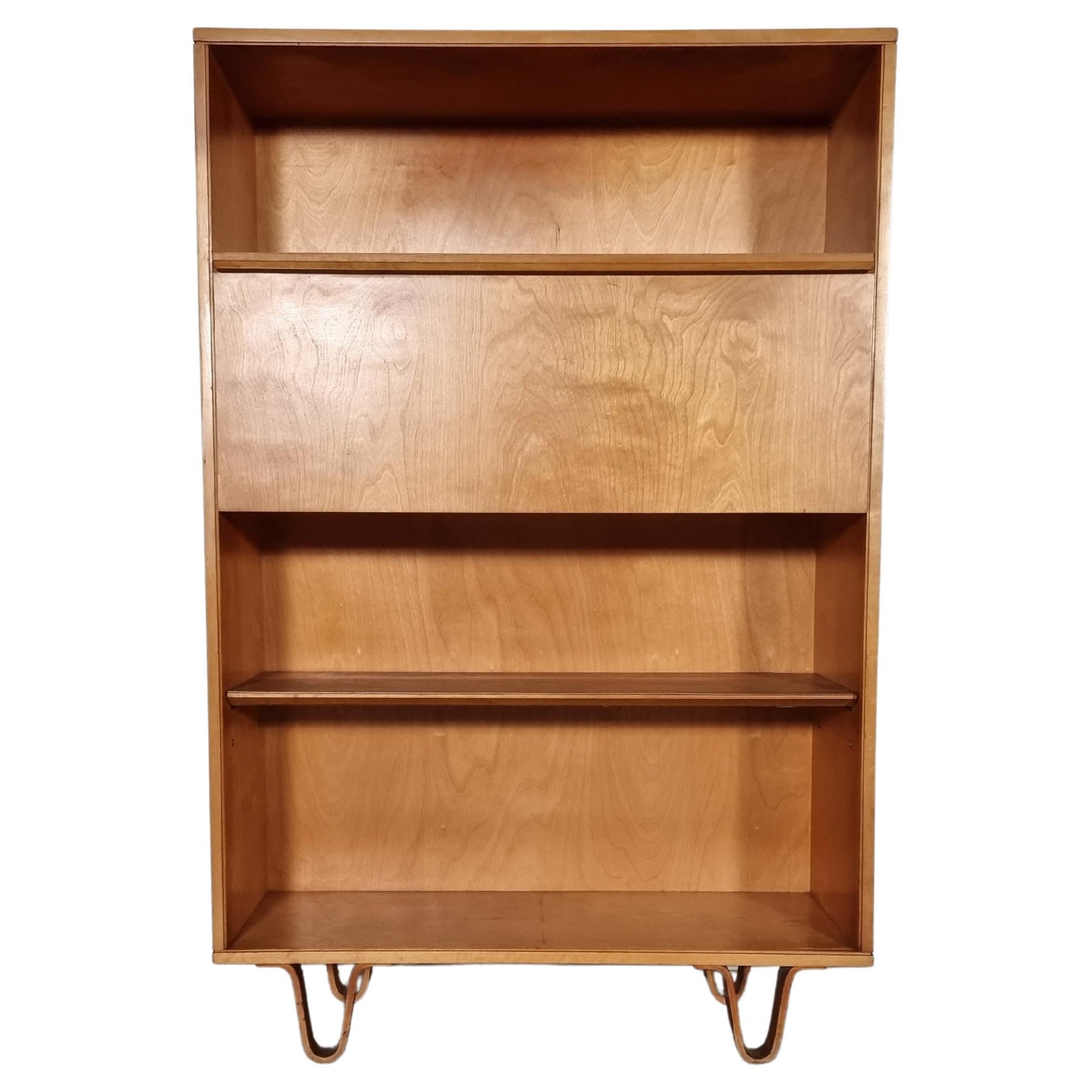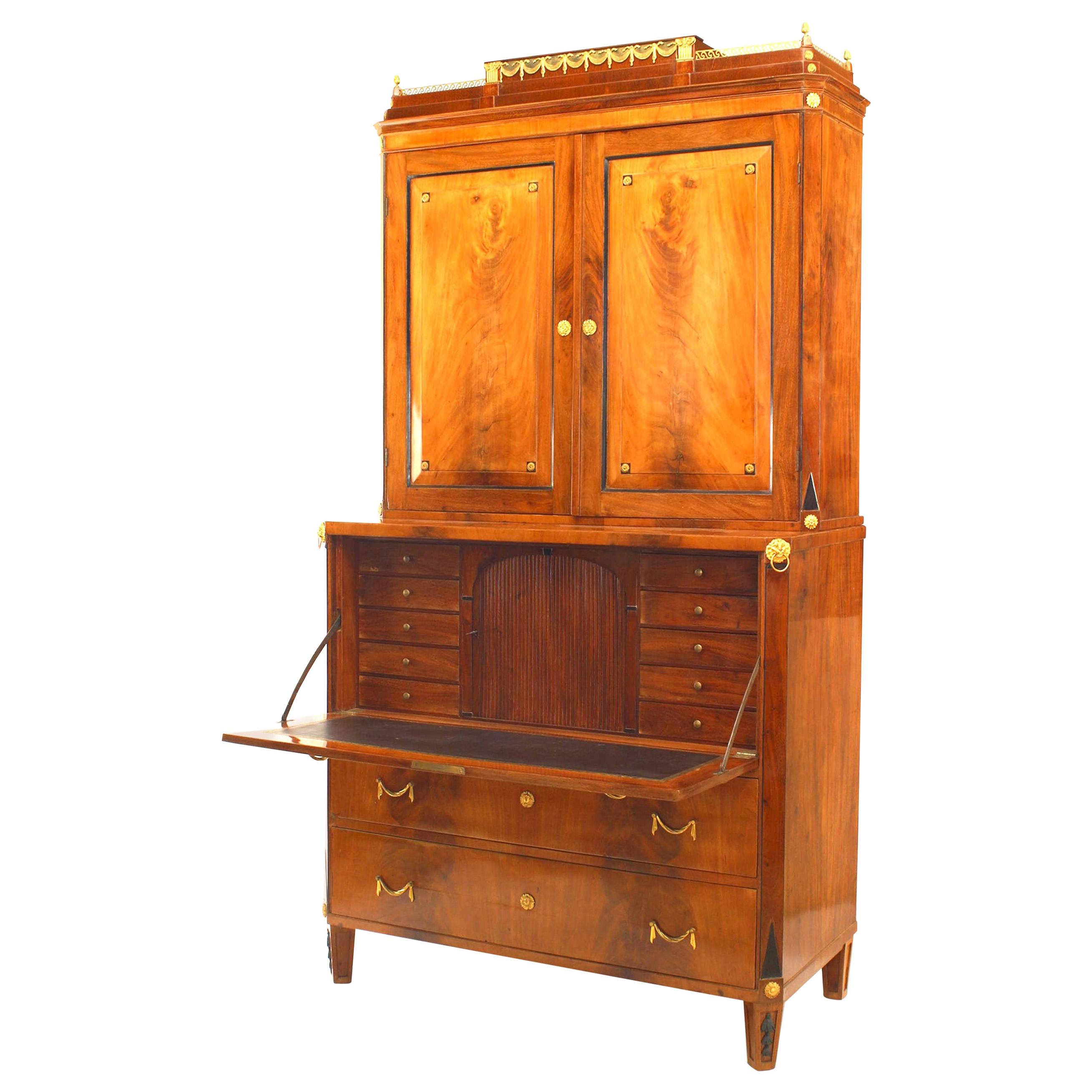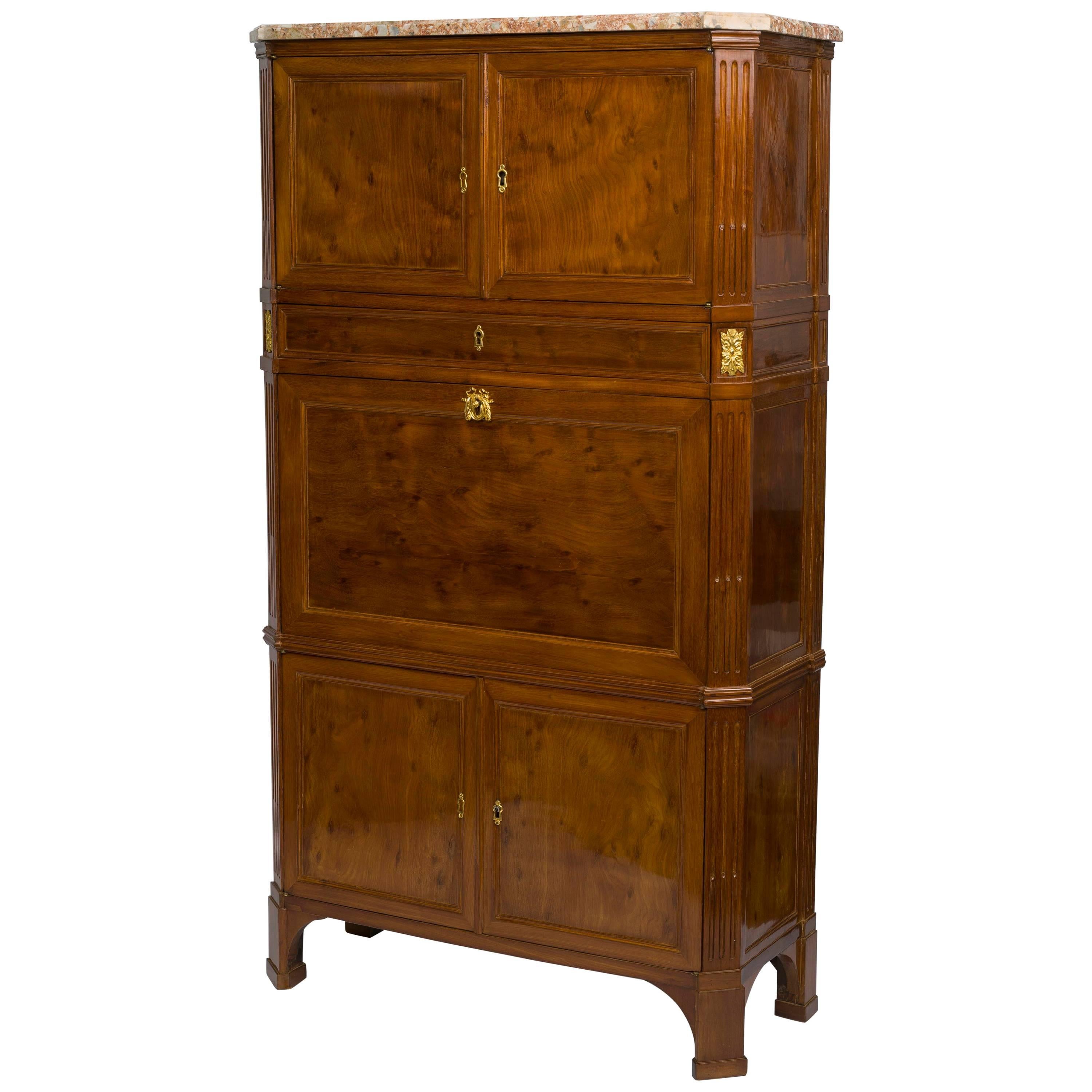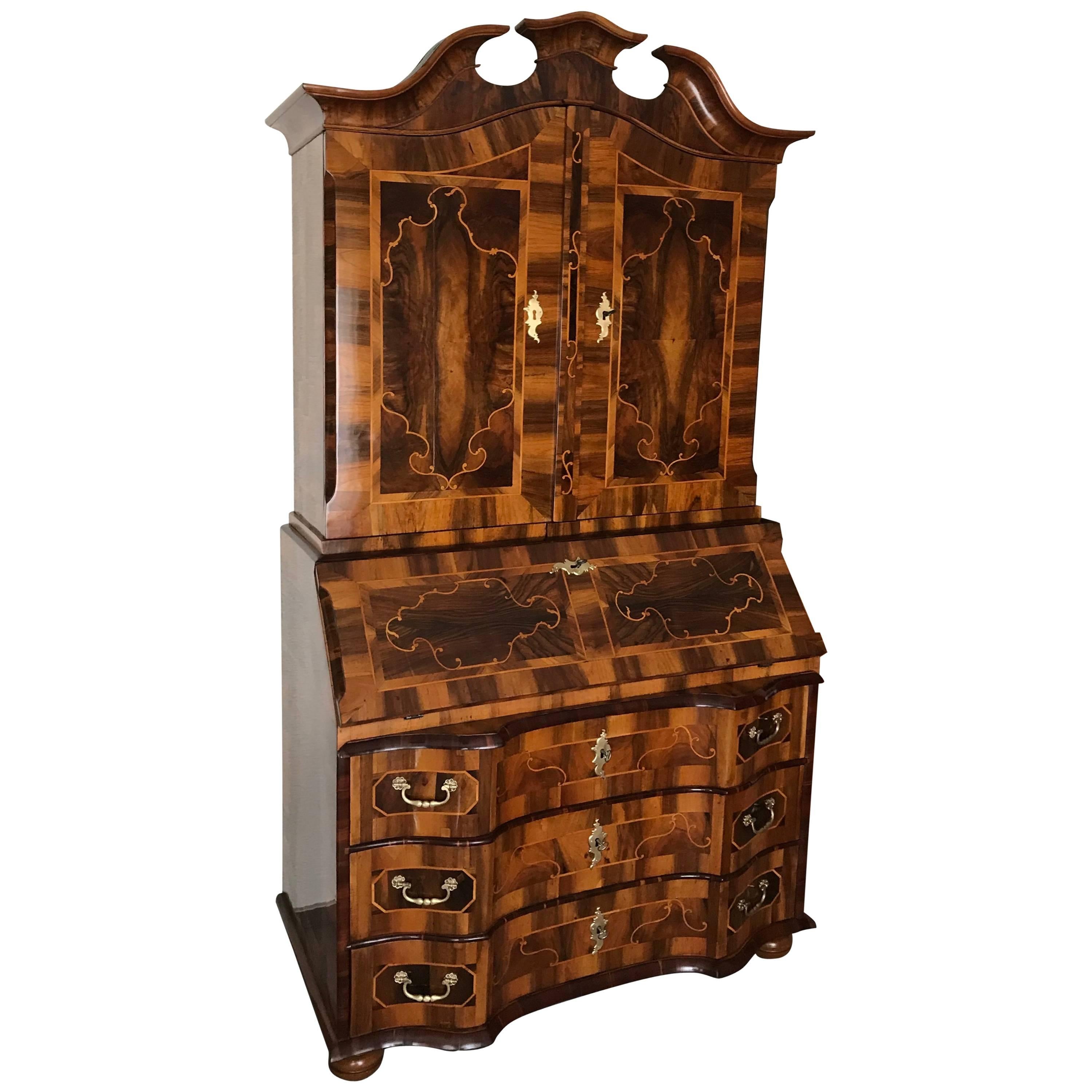Items Similar to Italian Mahogany Secretaire Cabinet, 1950s
Want more images or videos?
Request additional images or videos from the seller
1 of 12
Italian Mahogany Secretaire Cabinet, 1950s
About the Item
Precious cabinet secretaire produced in Italy in the 1950s,
The whole cabinet is veneered in mahogany with a fine solid wood carving in the center of the two doors representing two bunches of grapes.
The interiors are in maple.
Completely restored
- Dimensions:Height: 50.4 in (128 cm)Width: 55.12 in (140 cm)Depth: 16.54 in (42 cm)
- Style:Mid-Century Modern (Of the Period)
- Materials and Techniques:
- Place of Origin:
- Period:
- Date of Manufacture:1950s
- Condition:Refinished. Repaired.
- Seller Location:Meda, IT
- Reference Number:1stDibs: LU2103321796732
About the Seller
5.0
Vetted Seller
These experienced sellers undergo a comprehensive evaluation by our team of in-house experts.
Established in 1989
1stDibs seller since 2016
104 sales on 1stDibs
Typical response time: 4 hours
- ShippingRetrieving quote...Ships From: Meda, Italy
- Return PolicyA return for this item may be initiated within 1 day of delivery.
More From This SellerView All
- Italian Art Deco Aquamarine Shagreen Secretaire, Attr. to Borsani, 1940sBy Osvaldo BorsaniLocated in Meda, MBThis Art Deco secretaire was produced in Italy in the 1940s and is attributable to Osvaldo Borsani. It is completely in an exotic wood with a black lacquered top and base. The centra...Category
Vintage 1940s Italian Art Deco Secretaires
MaterialsMetal
- Italian Art Deco Maple Briar, Gold Leaf and Black Lacquered Secretaire, 1940sLocated in Meda, MBThis Art Deco secrétaire was produced in Italy in the 1940s. It is completely made of an elegant maple briar, with black lacquered and gold leafed details. In particular, some of t...Category
Vintage 1940s Italian Art Deco Secretaires
MaterialsGold Leaf
- Italian Art Deco Walnut and Briar Cabinet, 1940sLocated in Meda, MBFine Italian Art Deco cabinet from the 1940s with briar fronts and walnut sides. The handles are in brass while the profiles are black lacquered. Top in rare green marble. Similar...Category
Vintage 1940s Italian Art Deco Cabinets
MaterialsMarble, Brass
- Italian Art Deco Parchment and Black Lacquer Cabinet, 1940sLocated in Meda, MBThis little Art Deco cabinet was produced in Italy in the 1940s. It is completely black lacquered, while the door and the top are in parchment. Keys and keyhole are in brass. Com...Category
Vintage 1940s Italian Art Deco Cabinets
MaterialsBrass
- Italian Art Deco Parchment and Black Lacquer Cabinet, 1940sLocated in Meda, MBThis particular little cabinet was produced in Italy in the 1940s. The structure and the handles are black lacquered, while the doors and the drawer is in parchment.Category
Vintage 1940s Italian Art Deco Cabinets
MaterialsLacquer, Parchment Paper
- Italian Engraved Murano Glass Mirror Cabinet, Art Deco StyleLocated in Meda, MBThis Art Deco style Cabinet was produced in Italy in the 1980s circa. It is completely covered of Murano Glass bevelled panels. The real star of this piece is her majesty the engraving. The patterns on the mirrors, obtained by means of its grinding wheel...Category
Vintage 1980s Italian Art Deco Cabinets
MaterialsMirror, Murano Glass
You May Also Like
- Cabinet Secretaire by Cees Braakman for Pastoe, 1950sBy Cees Braakman, PastoeLocated in amstelveen, NLA wonderful piece from the Birch - series with distinctive laced legs. Designed by Cees Braakman for Pastoe in the early 1950s. Bookcase with 2 shelves an...Category
Vintage 1950s European Mid-Century Modern Secretaires
MaterialsBirch
- 18th Century Mahogany Secretaire Bookcase China CabinetLocated in Lymington, GBA fine English mid-18th century mahogany secretaire / secretary / bookcase / china cabinet. Of lovely, deep, rich color, patina and quality. George III period, circa 1760. The bold, detachable, swan-neck pediment carved with 'Gothic' open fretwork, spiral rosettes and a dentil cornice. The pediment is centred by a small platform below which is a fluted panel. The bookcase / china cabinet section with two, thirteen-pane glazed doors, with three original adjustable shelves with applied beadings for the display of china etc. The base with a pull-out writing section fitted with small drawers, two of which have secret releases. These secret drawers are faced with blind-fret 'Gothic' tracery, and centred by a carved, shaped arch. The base with three cock-beaded drawers, and raised on its original bracket feet which are faced with blind fret. This fine, sophisticated and well-proportioned example of a secretaire / secretary / cabinet / desk / bookcase is remarkable for having survived in its original state including all swan-neck handles and locks. Of superb quality, color, patination, and well figured throughout. With mahogany drawer linings: further confirmation of its quality. Measures: 42" wide (107 cm) 23" deep 58.5 cm) 95" high (241 cm) - without cartouche. A related antique bureau cabinet...Category
Antique 1740s English Cabinets
MaterialsMahogany
- Russian Neoclassic Mahogany SecretaireLocated in New York, NYRussian Neoclassic (Late 18th/ Early 19th Century) ormolu mounted ebonized and mahogany secretaire cabinet with a Pair of doors above a fitted fall...Category
Antique Early 19th Century Russian Neoclassical Secretaires
MaterialsOrmolu
- King George I Ambassadorial Secrétaire-CabinetLocated in New Orleans, LAThis highly important secrétaire-cabinet was crafted for and specially ordered by King George I for the British Ambassador to Russia. From its craftsmanship and materials to its exceptional artistry, it is a work of royal and historic significance that exudes power in each and every detail. The broken pediment at its apex features the simplified royal coat of arms bearing the king’s crown, while the interior is adorned by portraits of the British Royal Family. Placed within the ambassador’s St. Petersburg home, this entirely unique piece of furniture would have been a potent reminder of England's grandeur and political importance. Relations between England and Russia during this period were at an all-time high. Peter the Great had traveled to England in 1698 as part of his widely known “Grand Embassy” tour, wherein he attempted to gain foreign support against the Ottoman Empire. He spent a period of nearly four months there, meeting with King William III and his court on numerous occasions. Noted academic Arthur MacGregor wrote concerning the impact of the trip, “For two decades following Peter's visit, British influence in Russia reached a peak. It manifested itself in social custom, in craft practice and in ships and naval organization... it reached a significant sector of the population before relations cooled once again and the two nations pulled back from this era of unprecedented cordiality.” First and foremost, however, it is a reminder of British might and influence. By the reign of King George I, England had come into its own as a world power. Unique in its design, this cabinet is a reflection of the country’s might. It is crafted from the highest-quality solid walnut and burr walnut adorned by gilded lock plates and engraved hinges. The presence of ormolu at its apex and lining the doors was a rarity for this period, and its addition makes manifest the importance of the design. The outer doors open to reveal multiple interiors, including fifteen separate drawers around a central cupboard; the cupboard doors each bear mezzotint portraits of George I and his father, Ernest Augustus, Elector of Hanover. An etching after the portrait of George I dating to circa 1716 is in London’s Royal Academy. A second, inner pair of doors are adorned by mezzotints of the Prince and Princess of Wales (later Queen Caroline and George II), which are both after portraits by Sir Godfrey Kneller dated 1716 in the Royal Collection. A final portrait is revealed on the very interior of the cabinet, where a mezzotint of Frederick, Anne, Amelia and Caroline, children of the Prince of Wales, resides. An etching (circa 1715-1720) after this portrait can be found in the National Portrait Gallery (London). Apart from its abundance of royal portraiture, the cabinet features stunning painted decoration, including floral designs as well as clouds, birds and trees in a bucolic motif reminiscent of Eden. Its lower portion is a study in both form and function, featuring a fitted secrétaire-drawer above three additional drawers for storage. The cabinet appears in The Shorter Dictionary of English Furniture by R. Edwards from 1964, a text that is regarded as the bible of British furniture design. Edwards describes it as a “writing cabinet...given by George I to the British Ambassador at the Russian court.” The cabinet was likely made for the 18th-century German diplomat and writer Friedrich Christian Weber, who represented English interests at the Russian court from 1714 until 1719. Although Weber’s tenure as ambassador was relatively short, while in St. Petersburg, he authored his account entitled Das veraenderte Russland (The Present State of Russia), which was published in three volumes in 1721, 1739 and 1740. It may, however, also have been made for George Douglas, 2nd Earl of Dumbarton, who served as ambassador alongside Weber in 1716. Diplomatic relations ceased between the two countries in 1721. In 1928, the cabinet appeared for sale at the International Exhibition of Antiques & Works of Art in Olympia. It had previously been in the collection of the Woltner family of Bordeaux, the celebrated vintners who owned the estate Château Laville Haut-Brion and produced wine of the same name. According to the family, Monsieur Woltner was given the cabinet as a gift from an aunt who lived in Russia for many years. After leaving the Woltner collection, the cabinet was acquired by William Berry...Category
Antique 18th Century English Georgian Secretaires
MaterialsBrass
- Louis XVI Ormolu-Mounted Mahogany Secrétaire en Cabinet by Jean-Francois LeleuBy Jean-François LeleuLocated in Kittery Point, METhe later breccia marble top over two paneled doors opening to reveal shelves, above a drawer over a fall front with an interior fitted with drawers and compartments, and two further...Category
Antique Late 18th Century French Louis XVI Cabinets
- Baroque Cabinet with Secretaire, Germany 1750Located in Belmont, MAStunning original baroque cabinet, Germany 1750. The cabinet originates from the area of the city of Brunswick. Walnut, plum wood and satinwood veneer. The cabinet will be directly s...Category
Antique 1750s German Baroque Cabinets
MaterialsWalnut
Recently Viewed
View AllMore Ways To Browse
Retro Italian Kitchen
Italian Modern Cabinet
Modern Italian Cabinets
Cabinet Modern Italy
Mahogany 1950s Furniture
1950s Mahogany
Restored Vintage Cabinet
Retro Mahogany Cabinet
Carving Cabinet
Mahogany Italy
Mahogany Kitchen Cabinets
Italian Kitchen Cabinets
Mahogany Veneer Cabinet
Mahogany Mid Century Modern Cabinet
Cabinet Italy Veneer
1950s Kitchen Cabinet
Vintage 1950S Kitchen Cabinets
1950s Italian Cabinet





